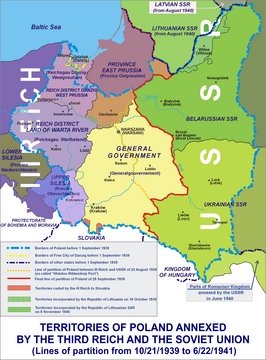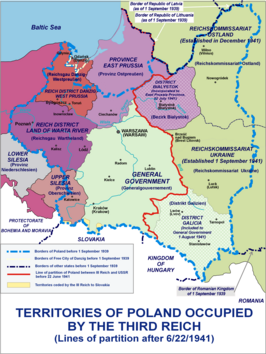Subdivisions of Polish territories during World War II
Subdivision of Polish territories during World War II can be divided into several phases. The territories of the Second Polish Republic were first administered first by Nazi Germany (in the west) and the Soviet Union (in the east), then (following the German invasion of the Soviet Union) in their entirety by Nazi Germany, and finally (following Soviet push westwards) by the Soviet Union again. In 1946, administrative control of the areas not annexed by the Soviet Union was returned to Poland.
| Division of interwar Poland by the occupying powers | |
|---|---|
| 1939–41 | |
 Fourth Partition of Poland – aftermath of the Nazi–Soviet Pact; division of Polish territories in the years 1939–1941 | |
| 1941–44 | |
 Changes in administration of Polish territories following the German invasion of the Soviet Union in 1941. The map shows the state in 1944 |
After Germany and the Soviet Union conquered Poland in 1939, they partitioned the country. Germany took most of the ethnically Polish territory. The area annexed by the Soviet Union was ethnically diverse: Poles were the largest single ethnic group, but there were non-Polish majorities in some regions: Ukrainians in the south and Belarusians in the north.[1] Many of these people had felt alienated in the interwar Poland and welcomed the Soviets.[2]
Soviet zone (1939–1941)
editBy the end of the Polish Defensive War the Soviet Union had taken over 52.1% of the territory of Poland (circa 200,000 km2), with over 13,700,000 people. The estimates vary; Professor Elżbieta Trela-Mazur gives the following numbers in regards to the ethnic composition of these areas: 38% Poles (ca. 5.1 million people), 37% Ukrainians, 14.5% Belarusians, 8.4% Jews, 0.9% Russians and 0.6% Germans. There were also 336,000 refugees from areas occupied by Germany, most of them Jews (198,000).[2] Areas occupied by the USSR were annexed to Soviet territory, with the exception of area of Wilno, which was transferred to Lithuania, although soon attached to USSR, when Lithuania became a Soviet republic.
Under the terms of the Molotov–Ribbentrop pact, adjusted by agreement on 28 September 1939, the Soviet Union, annexed all Polish territory east of the line of the rivers Pisa, Narew, Bug and San, except for the area around Wilno (Vilnius), which was given to Lithuania, and the Suwałki region, which was annexed by Germany. These territories were largely inhabited by Ukrainians and Belarusians, with minorities of Poles and Jews (see exact numbers in Curzon line). The total area, including the area given to Lithuania, was 201,000 square kilometres, with a population of 13.5 million. A small strip of land that was part of Hungary before 1914, was also given to Slovakia.
German zone (1939–1945)
editAnnexation of selected Polish territories
editUnder the terms of two decrees by Hitler (8 October and 12 October 1939), large areas of western Poland were annexed to Germany. These included all the territories taken by Prussia in Partitions of Poland which Germany subsequently lost under the 1918 Treaty of Versailles, including the Polish Corridor, Wielkopolska, as well as territories divided after plebiscites such as Upper Silesia, as well as a large area east of these territories, including the city of Łódź.
The area of these annexed territories was 94,000 square kilometres and the population was about 10 million, the great majority of whom were Poles. The annexed parts were controlled by a German administration ruled by a Gauleiter, a system similar in practice to that of the Reich itself. Nearly 1 million Poles were expelled from this German ruled area, while 600,000 Germans from eastern Europe and 400,000 from the German Reich were settled there.
| Nazi German administrative units | Annexed administrative units | ||
|---|---|---|---|
| Reichsgau/Gau (province) |
Regierungsbezirk (government region) |
Polish voivodeship/ State |
Counties |
| Reichsgau Wartheland (Warthegau) initially Reichsgau Posen[3] |
Posen Hohensalza Litzmannstadt5 |
Poznań | all counties |
| Łódź | most counties | ||
| Pomeranian | five counties | ||
| Warsaw | one county | ||
| Reichsgau Danzig-West Prussia1 (Danzig-Westpreußen) initially Reichsgau West Prussia |
Bromberg Danzig1 Marienwerder1 |
Greater Pomeranian | most counties |
| Free City of Danzig | |||
| East Prussia1 (Ostpreußen) southernmost part2 |
Zichenau Gumbinnen1 |
Warsaw | Ciechanów, Działdowo, Maków, Mława, Płock, Płońsk, Przasnysz, Sierpc; parts of Łomża, Ostrołęka, Pułtusk, Sochaczew, Warsaw |
| Białystok | Suwałki and part of Augustów | ||
| Bezirk Bialystok (attached in 1941)6 |
Białystok | Białystok, Bielsk Podlaski, Grajewo, Łomża, Sokółka, Volkovysk, Grodno | |
| (Upper) Silesia1,3 (Oberschlesien) easternmost part4 |
Kattowitz Oppeln1 |
Autonomous Silesian | |
| Kielce | Sosnowiec, Będzin, Zawiercie, Olkusz | ||
| Kraków | Chrzanów, Oświęcim, Żywiec[4] | ||
| 1 Gau or Regierungsbezirk only partially comprised annexed territory 2 the annexed parts are also referred to as "South East Prussia" (German: Südostpreußen) | |||
Creation of General Government
editThe remaining block of territory was placed under a German administration called the General Government (in German Generalgouvernement für die besetzten polnischen Gebiete), with its capital at Kraków. The General Government was subdivided into four districts, Warsaw, Lublin, Radom, and Kraków (Distrikt Krakau).
A German lawyer and prominent Nazi, Hans Frank, was appointed "Governor-General of the occupied Polish territories" on 26 October 1939. Frank oversaw the segregation of the Jews into Nazi ghettos in the larger cities, particularly Warsaw, and the use of Polish civilians as forced and slave labour in German war industries.
German invasion of the Soviet Union
editAfter Operation Barbarossa, the June 1941 German invasion of the Soviet Union, the Polish territories previously annexed to the Ukrainian and Byelorussian republics were organized by the Germans as follows:
- Bezirk Bialystok (district of Białystok), which included the Białystok, Bielsk Podlaski, Grajewo, Łomża, Sokółka, Volkovysk, and Grodno counties, which was "attached to" (but not incorporated into) East Prussia;
- Generalbezirk Litauen – the Vilna Province was incorporated into Lithuania, itself incorporated into the Reichskommissariat Ostland;
- Generalbezirk Weißruthenien – "White Ruthenia" (the western section of modern-day Belarus) was incorporated into the Reichskommissariat Ostland;
- Generalbezirk Wolhynien und Podolien – the Polish province of Volhynia, which was incorporated into the Reichskommissariat Ukraine; and
- East Galicia, which was incorporated into the General-Government and became its fifth district, the Galician District (Distrikt Galizien).
Return of Soviet administration (1944–1945)
editSoviet forces returned to former territories of the Second Polish Republic during the 1944 summer offensive, Operation Bagration, specifically in the Lublin–Brest Offensive), leading to Vistula–Oder Offensive of 1945. However, in terms of international politics, a far more important victory was won by Joseph Stalin already in 1943, when the Western Allies yielded to his demands during the Tehran Conference, for the annexation of eastern Poland by the Soviet Union.[5]
With full Soviet control and sponsorship, in July 1944, the Polish Committee of National Liberation (Polski Komitet Wyzwolenia Narodowego, PKWN), a Polish provisional government was formed. Its purpose was to administer the territories earmarked for the return to the newly reformed Poland. Starting with the communist decrees of 1946, the legal powers were passed on to local administration (see Administrative division of People's Republic of Poland).[6]
Destruction of the Polish Underground State
editThroughout World War II, Poland had a unique underground administration maintained by the Polish Underground State. For regional divisions of Poland by the underground army known as Armia Krajowa, see areas and regions of operation. Following the German surrender, Soviet agencies such as NKVD and SMERSH proceeded to eliminate all structures originating from the prewar Second Polish Republic. Over 20,000 Poles, including the hero of Auschwitz, Witold Pilecki, were murdered in communist prisons.[7]
See also
editNotes
edit- ^ Jan Tomasz Gross, Revolution from Abroad, pp. 4, 5, Princeton, 2005, ISBN 0-691-09603-1
- ^ a b Elżbieta Trela-Mazur (1997). Włodzimierz Bonusiak; Stanisław Jan Ciesielski; Zygmunt Mańkowski; Mikołaj Iwanow (eds.). Sowietyzacja oświaty w Małopolsce Wschodniej pod radziecką okupacją 1939–1941. Kielce: Wyższa Szkoła Pedagogiczna im. Jana Kochanowskiego. p. 294. ISBN 8371331002 – via Google Books.
Of the 13.5 million civilians living in Polish areas annexed by the Soviet Union according to the last official Polish census, the population was over 38% Poles (5.1 million), 37% Polish Ukrainians (4.7 million), 14.5% Belarusians, 8.4% Jews, 0.9% Russians and 0.6% Germans.
{{cite book}}:|work=ignored (help) - ^ Piotr Eberhardt, Political Migrations in Poland, 1939–1948, Warsaw 2006, "Archived copy" (PDF). Archived from the original (PDF) on 18 October 2011. Retrieved 8 February 2016.
{{cite web}}: CS1 maint: archived copy as title (link): 10,568,000 people - ^ Ryszard Kaczmarek Górnoślązacy i górnośląscy gauleiterzy Biuletyn IPN NR 6–7 (41–42) 2004 page 46
- ^ Robert Gellately (2013). Stalin's Curse: Battling for Communism in War and Cold War. Oxford U.P. pp. 177–178. ISBN 9780191644887.
- ^ Norman Davies, God's Playground: A History of Poland. Vol 2. New York: Columbia University Press, 1982 and several reprints. ISBN 0-231-05353-3 and ISBN 0-231-05351-7.
- ^ Rzeczpospolita, 02.10.04 Nr 232, Wielkie polowanie: Prześladowania akowców w Polsce Ludowej (Great hunt: the persecutions of AK soldiers in the People's Republic of Poland). Internet Archive.